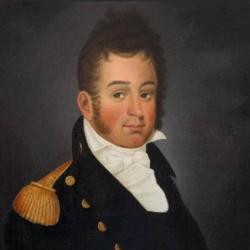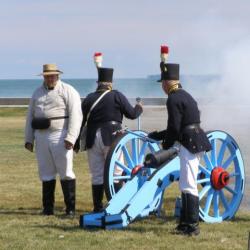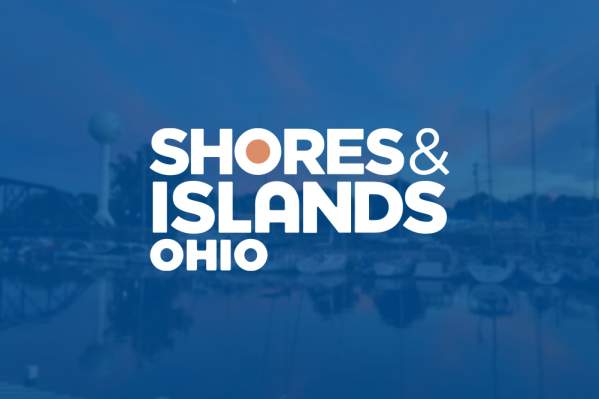 Part of our Time Traveler Series.
Part of our Time Traveler Series.
Have you ever been traveling around the region and wondered why there is a Perry St. or Perry’s Monument (or to be precise, Perry’s Victory and International Peace Memorial)? If you grew up in the area, then you are most likely familiar with the local namesake who led the U.S. to a maritime victory against the British in 1813. And it’s not limited to the Shores & Islands Ohio area. Communities all across the lakeshore, from Toledo, OH to Erie, PA, have placenames and memorials in his honor. For those readers from outside of our region (or a refresher for the rest of us!), let’s give you a bit of the story.
During the War of 1812, the British and U.S. were battling over many parts of our nation, but particularly the Great Lakes. With forts around the area, the British had a foothold on Lake Erie. To make a complex battle short, on Sept 10, 1813, Perry and his men defeated and captured six vessels from the British Royal Navy. This gave America control over Lake Erie and the recovery of Detroit from the British. The lake remained under U.S. control for the rest of the war, and the Battle of Lake Erie is viewed as part of a turning point for the U.S. Perry even received a Congressional Gold Medal and Thanks of Congress for the victory.
 But who was this man, so famed across Lake Erie? Oliver Hazard Perry was born in South Kingstown, Rhode Island on August 23, 1785. His father, Christopher Raymond Perry, was a member of the Continental Navy during the revolution, and O.H. Perry and his brother were both integral in establishing the new United States Navy in the early part of the 19th century. Following in his father’s footsteps, Perry joined the Navy at the age of 13, appointed as a midshipman on the USS General Greene, of which his father was the commanding officer. During this voyage, in 1800, Perry first experienced combat off the coast of Haiti, which at the time was in a state of rebellion. Perry went on to serve aboard the USS Adams during the First Barbary War, and then became first lieutenant of the USS Nautilus, and also served on several other ships during this time.
But who was this man, so famed across Lake Erie? Oliver Hazard Perry was born in South Kingstown, Rhode Island on August 23, 1785. His father, Christopher Raymond Perry, was a member of the Continental Navy during the revolution, and O.H. Perry and his brother were both integral in establishing the new United States Navy in the early part of the 19th century. Following in his father’s footsteps, Perry joined the Navy at the age of 13, appointed as a midshipman on the USS General Greene, of which his father was the commanding officer. During this voyage, in 1800, Perry first experienced combat off the coast of Haiti, which at the time was in a state of rebellion. Perry went on to serve aboard the USS Adams during the First Barbary War, and then became first lieutenant of the USS Nautilus, and also served on several other ships during this time.
It was in 1807, at a dance, that he met Elizabeth Champlin Mason, of Newport. The couple began courting. By 1809 Perry was commanding the sloop USS Revenge whose duty was to enforce the Embargo Act. In January of 1811, however, the ship ran aground and was lost. Perry was exonerated during the Court Marshall proceedings, as blame was placed upon the ship’s pilot. After being exonerated, Perry was given a leave of absence and in May 1811 he and Elizabeth finally wed, spending a long honeymoon traveling around New England.
 In fact, Perry did not return to active service until June of 1812, when the United States officially declared war with Great Britain. Perry was then called back to active duty and requested a posting at sea. Perry was disappointed to be placed in command of the flotilla being constructed on Lake Erie, but history proved this to be a boon. Much has been written about the famous Battle of Lake Erie, so I will not go into the details of the conflict here (Watch a short video from the National Parks Service). Perry’s quick maneuvering in a complex situation is often credited as the most important component of defeating the Royal Navy in this battle. Not only did Perry and Jesse Elliott gain fame, the ships USS Niagara and USS Lawrence gained notoriety as well as a slogan you may see around the region “Don’t Give Up the Ship.”
In fact, Perry did not return to active service until June of 1812, when the United States officially declared war with Great Britain. Perry was then called back to active duty and requested a posting at sea. Perry was disappointed to be placed in command of the flotilla being constructed on Lake Erie, but history proved this to be a boon. Much has been written about the famous Battle of Lake Erie, so I will not go into the details of the conflict here (Watch a short video from the National Parks Service). Perry’s quick maneuvering in a complex situation is often credited as the most important component of defeating the Royal Navy in this battle. Not only did Perry and Jesse Elliott gain fame, the ships USS Niagara and USS Lawrence gained notoriety as well as a slogan you may see around the region “Don’t Give Up the Ship.”
While clearly quick thinking, Perry was also known to be quick tempered. He had disagreements and conflicts with many crew throughout his career. One of the most notable was his battle with the second-in-command of his Lake Erie Battalion, Jesse Elliott. While just after the win, Perry wrote seemingly in praise of Elliott, this sentiment quickly changed. The two began a heated rivalry that nearly ended in a duel. The duel was scheduled but no shots were ever fired.
 While involved with this historic battle, and through several other commands, Perry and his wife had five children between the years of 1812 and 1816. Four of their children lived to adulthood, and two of their sons followed the family tradition and were involved with the U.S. Navy (Christopher Grant Champlin Perry and Oliver Hazard Perry, Jr.), and their son Christopher Raymond Perry fought and died in the Mexican-American War. Their daughter, Elizabeth Mason Perry, married a pastor and remained in Newport.
While involved with this historic battle, and through several other commands, Perry and his wife had five children between the years of 1812 and 1816. Four of their children lived to adulthood, and two of their sons followed the family tradition and were involved with the U.S. Navy (Christopher Grant Champlin Perry and Oliver Hazard Perry, Jr.), and their son Christopher Raymond Perry fought and died in the Mexican-American War. Their daughter, Elizabeth Mason Perry, married a pastor and remained in Newport.
It may have been Perry’s short temper that led him to have difficulties in many of his later commands throughout the America’s and the Mediterranean. In addition, Perry’s conflict with Elliott had escalated to the point that in 1818 Perry filed court martial charges against Elliott. Not wishing to cause a stir or tarnish the reputation of two people considered war heroes, President Monroe offered Perry a diplomatic mission to Venezuela. Taking a small schooner upriver to the city of Angostura, Perry met and negotiated an anti-piracy treaty with President Simone Bolivar. It’s at this point Perry’s story takes an unfortunate turn, while heading downriver Perry contracted Yellow Fever. On August 23, 1819, Oliver Hazard Perry died aboard the USS Nonsuch, his 34th birthday.
Learn more about Oliver Hazard Perry and the Battle of Lake Erie, when you visit the nation’s third-tallest national monument, Perry’s Victory and International Peace Memorial at Put-in-Bay, on South Bass Island. This site is operated by the National Park Service so you may be able to enjoy Ranger programs during your visit as well. Timed tickets to access the observation deck, 317 foot up the memorial, are $10 for those 16 and older (15 and under are free when accompanied by an adult) and can be purchased in the Visitor Center.



